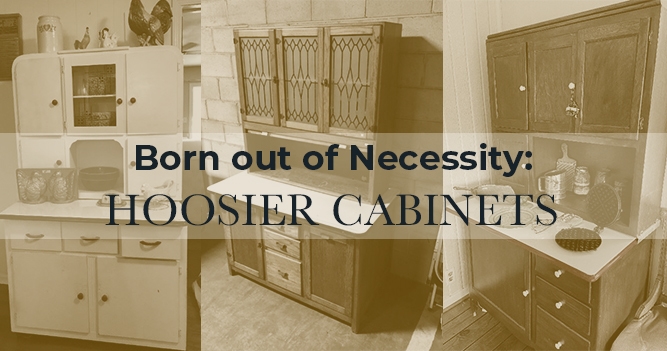Born Out of Necessity: Hoosier Cabinets

One of the best things about working at EstateSales.NET is talking to you all about the treasures you've found at estate sales. I was recently talking to one of our customers from Rockford, Illinois. She couldn't wait to tell me about a pristine Hoosier Cabinet that she came across. I wasn't 100% sure what a Hoosier Cabinet was. I was excited because she was excited. I immediately started researching to see what all the fuss was about, and I am glad I did.
The old adage "Necessity is the mother of invention" has been confirmed for mostly all of the things I write about, and the Hoosier Cabinet is no exception. Originating in New Castle, Indiana (hence the Hoosier moniker), these multi-purpose workstations solved a few different problems. While houses built in the early 1900s (like mine) may have been made to last, they weren't necessarily built for functionality. Most homes lacked kitchen storage and workspace, so the Hoosier Cabinet served to remedy all of those problems at once.
The Kitchen Cabinet that Saves Miles of Steps
Aside from a massive collection of depression glass and Tupperware, my grandmother was the proud owner of a beautiful baker's rack that sat in her kitchen for as long as I can remember. Flour and sugar canisters, cookbooks, and spices were all kept on it. The Hoosier cabinet is a take on the traditional baker’s rack but with a few improvements. Aside from being aesthetically pleasing, several features made these cabinets extremely innovative. Slide-out shelves, countertops, sugar and flour bins, and a shopping list holder are just a few features that had folks itching to get back in the kitchen.
Like most innovations, it took a while for the Hoosier Cabinet to pick up steam, but when the trend caught on, these cabinets were selling faster than they could be built. It's estimated that at least 10% of all homes owned one by the 1920s. While The Hoosier Manufacturing Company is said to be the originator of the cabinet, dozens of manufacturers began cranking out these beauties within a few years of its inception.
Goodbye, Hoosier. Hello, Cabinets.
Despite how game-changing the Hoosier Cabinets were, all good things must come to an end. I wish I had a more interesting story about why these cabinets fell out of popularity, but it's pretty simple. Around the 1930s, houses were built with more cabinets, so homeowners didn't require standalone storage anymore. It took a few decades before people began seeking Hoosier Cabinets out—but they're back and as popular as ever. People are adding these cabinets to their farmhouse aesthetic as a great way to add a little history and functionality to their home.
Get a Hoosier of your own!
Since there were millions of Hoosier Cabinets in existence at one time, the chances of you finding one are pretty good. However, finding one that has all of its original components is a different story. If you're lucky enough to find a pristine cabinet with all of the accessories, you could be looking at a price tag between $1500-2000. If you're a DIY'er and aren't afraid to get your hands dirty and want to restore it yourself, you can pick up a cabinet for a few hundred bucks. There are a few things you need to determine when hunting down one of these cabinets. Is it a reproduction? Has it been restored? Are the accessories original? One of the most important things to look for is the maker’s mark. Most manufacturers would put their mark on some sort of tag inside the cabinet. If you’re still not sure, consulting with an antiques expert will help you know if the cabinet you have is the real deal or not.
The Hoosier Cabinet is joining the long list of historical pieces making a fierce comeback to modern-day decor. It was a lot of fun learning about these cabinets, and I would love to see pictures if you come across any in the wild!
Love all things estate sales? Us, too! Head over to our blog to learn about all things vintage, DIY, and more!